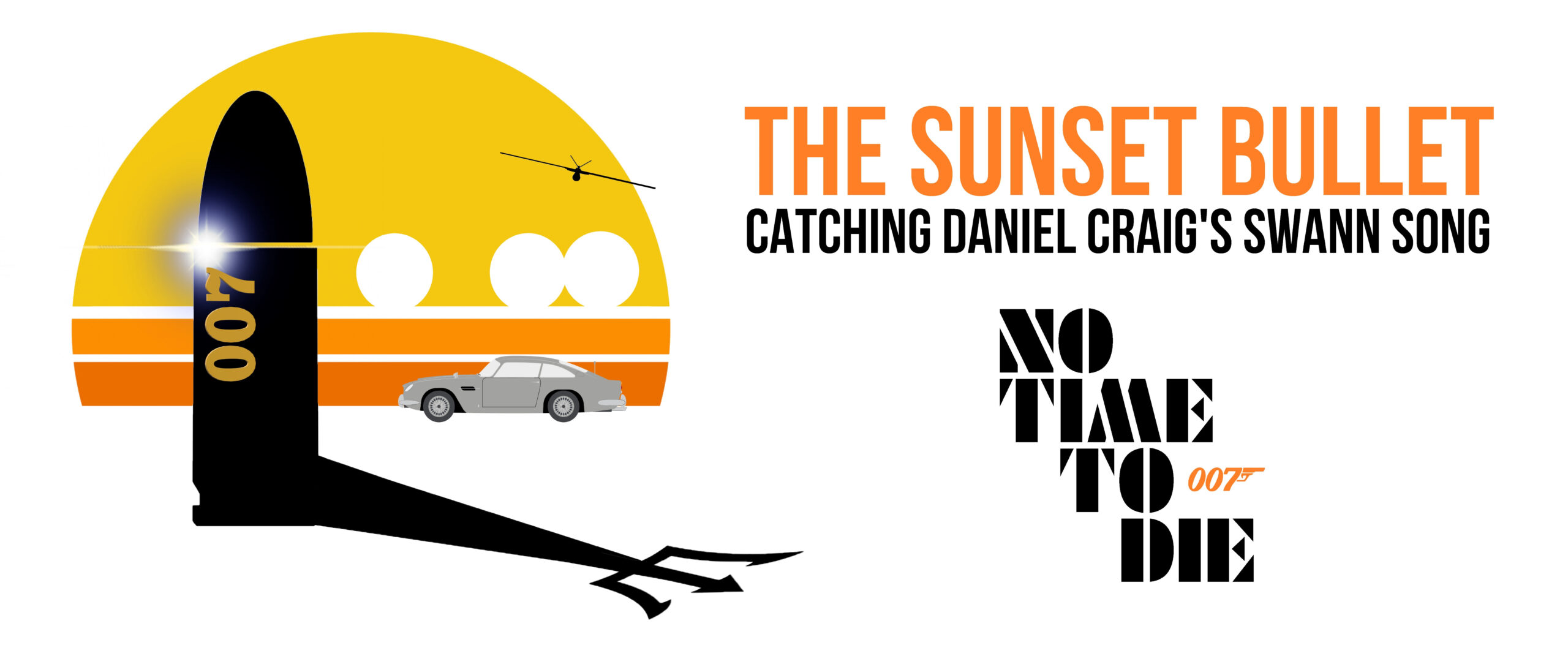
SPOILERS!
The treacherous journey of Bond’s twenty-fifth cinematic roll of the dice became a globally observed adventure of delays, postponements, and overconfident calls for 007 to ignore the delicate eco-systems of culture and industry he represents by streaming instantly. James Bond became the most famous poster boy for how the movie, entertainment and arts scenes across the world also had to temporarily retire from service altogether when 2020 created life sabbaticals for us all. As some studios knew they could release their lesser impactful wares to streaming platforms (Marvel and Disney only really streamed titles that were never in all honesty going to be billion-dollar theatrical hits), all goldeneyes were always on 007 and No Time to Die.
Yet, like an agent biding his time in a DB5 under a hail of vicious SPECTRE bullets, Bond held his ground. And as No Time to Die circles the globe firing at box-office registers like a Gatling gun on the streets of Matera, 007’s judgement was correct.
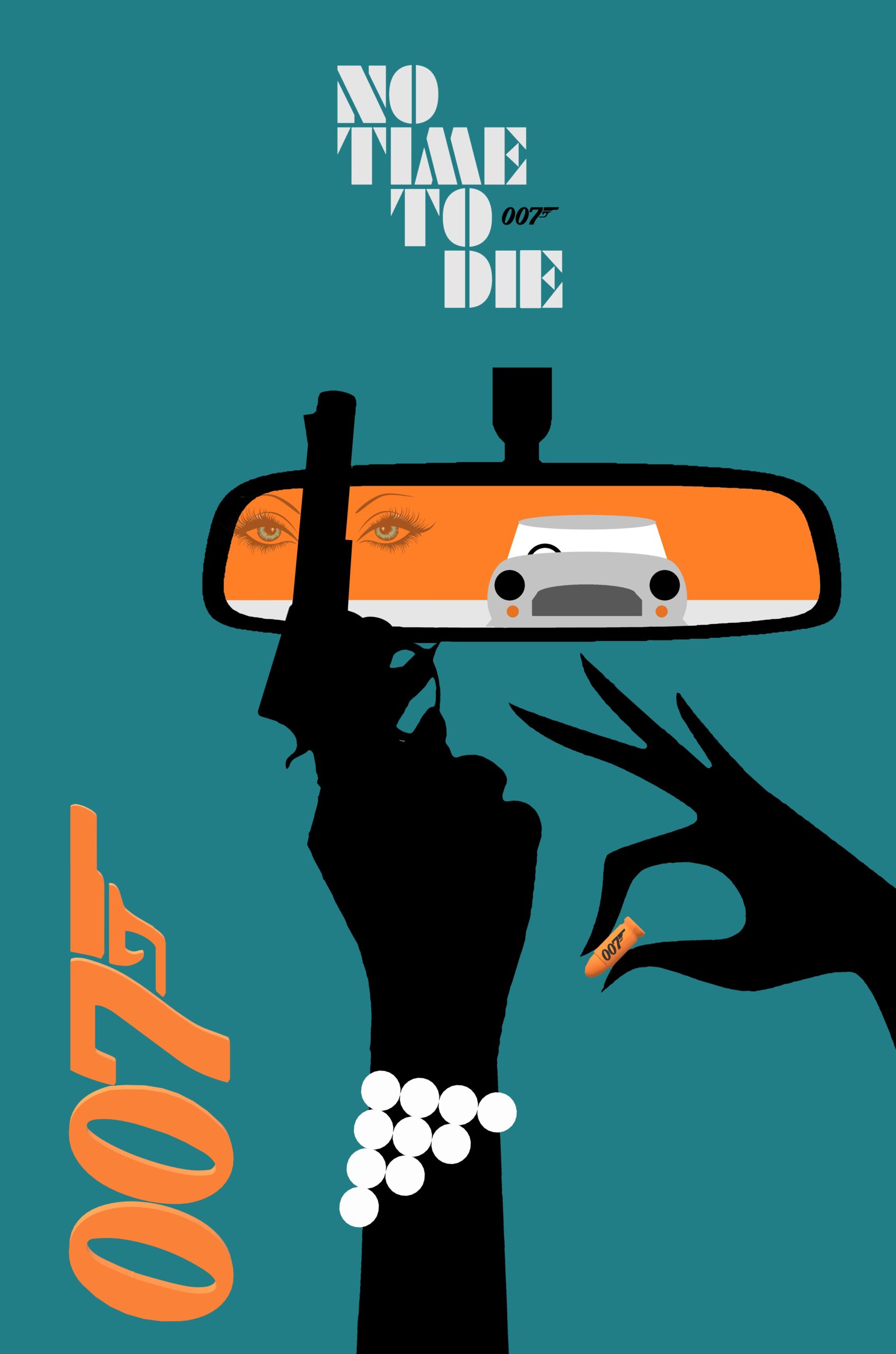
Rear View Bond © Mark O’Connell
As was EON Production’s decision to settle upon their first 1980s kid director whose favourite films include Platoon (1986), Goodfellas (1990), Boogie Nights (1997), Jaws (1975), Barry Lyndon (1975), Full Metal Jacket (1987) and Y Tu Mama Tambien (2001). Born three days after the world premiere of The Spy Who Loved Me (1977), the San Francisco raised Cary Joji Fukunaga is not only the first Bond director to cite A View to a Kill (1985) as his first Bond film – give him a Director’s Guild Lifetime Achievement trophy for that one alone! He also represents the contemporary zeal and movie youth the Bond registry now needs.
And there is no greater contemporary zeal in the first five minutes of No Time to Die than an onscreen movie youth terrorized by a masked villain in one of the premium overture beats of any Bond film. As her bedroom TV depicts Wallace and Gromit battling their evil penguin foe in The Wrong Trousers (1993), a young, Tamagotchi clutching Madeleine Swann (Coline Defaud) is about to combat both her melancholic mother’s addictions and a Michael Myers inspired foot-dragging intruder. With the real-life spousal tragedies of French singer Dalida and ‘Dans La Ville Endormie’ (‘My Year is a Day’) judiciously filling the soundtrack whilst Madeleine’s embittered mother (Mathilde Bourbin) carelessly spills her cigarette ash, wine box vino and emotions, director Fukunaga and cinematographer Linus Sandgren immediately remind of the lake house horrors of Michael Haneke’s Funny Games (2007).
As a masked intruder approaches a reeded glass door in a visual straight from an Italian Giallo horror – a movie movement whose masks and home invaders aptly inspired the American 1980s slasher pics also being mined here by Fukunaga – young Madeleine begins to play out a moment she has already described to us before. ‘A man once came to our house to kill my father’, her older self recalls in Spectre (2015), ‘– He didn’t know I was upstairs playing in my bedroom, or that Papa kept a Beretta 9mm under the sink with the bleach.’ It is a bravura moment of Scandi chill as a child shoots a stiffened villain only to drag his supposedly dead body down the Norwegian pine steps of a lake-side lounge musically foreboded by Dalida. And one panicked match cut later, and we are emerging from the Italian surf into composer Hans Zimmer’s finest cue on the soundtrack, John Barry’s finest cue on one of his Bond soundtracks and a mountainous road tunnel that emotionally bookends No Time to Die with a visual gunbarrel featuring two very different Aston Martins.
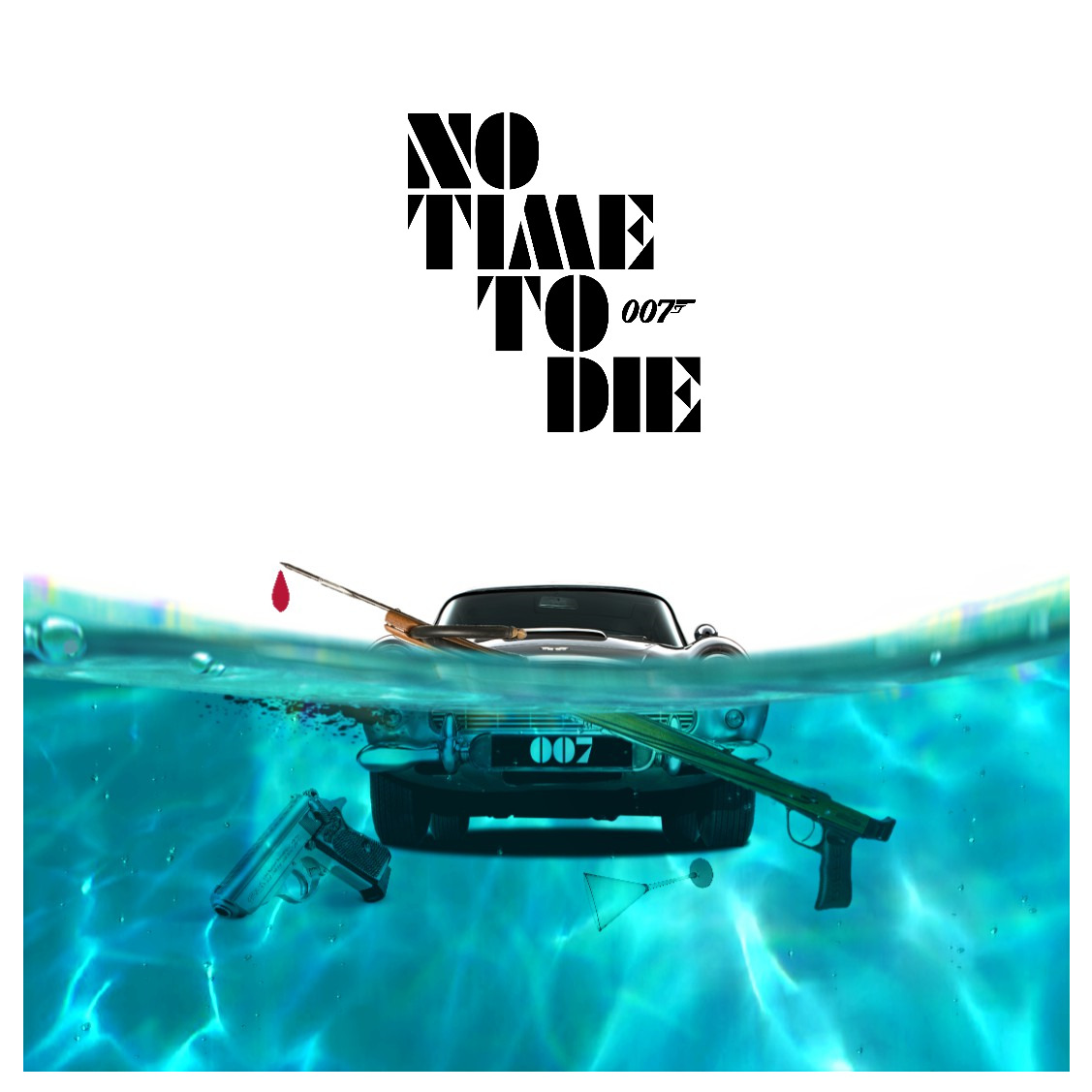
Art © Mark O’Connell
It was a challenge for a pre-title car chase that has played out on cinema screens and social media for eighteen months to keep itself fresh. The oft-repeated Matera sequence became globally emblematic of all franchise cinema’s struggles through the 2020 pandemic. It was the visual reference for all newsmakers looking at the worrying plight of movie houses, studios, and distributors throughout the world. Yet, the bangs and whistles of No Time to Die’s overture are not about screeching Aston Martins and Primo donnas riding Triumph bikes with CCTV eyeballs. It is about remembrance, Celestinian Forgiveness Walks and James Bond navigating a hillside necropolis in Matera with all the rustic foreboding of a scene from The Godfather (director Francis Ford Coppola even owns a hotel in the town).
For a nearly three-hour Bond bullet, No Time to Die pulls its pre-title punches with grace and grit. It is not about an impromptu swallow dive off an ancient bridge. It is not even about that ‘doughnut’ DB5 spin in a hail of smoke and bullets. It is about Madeleine Swann, the calculating silence of her bulletproof spy lover, and how his greatest personal tragedy was once in an Aston Martin flecked by bullet holes. The big stunt of No Time to Die’s opener is ultimately an emotional one – with a quivering, panicked Lea Seydoux overcome with familiar terror as Bond promptly abandons her to a departing train and a Daniel Kleinman title sequence.
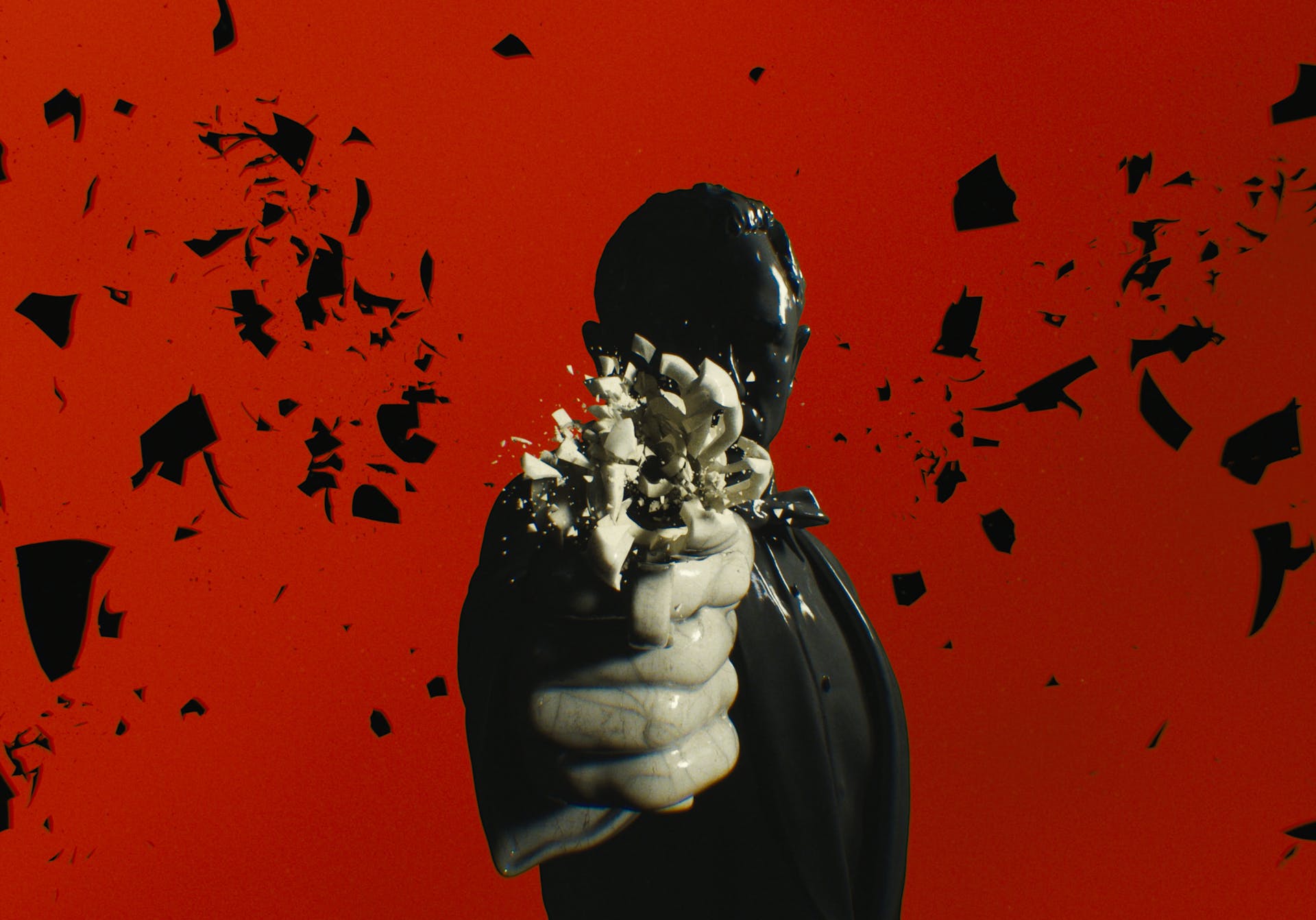
Photo © Rattling Stick / Danjaq & MGM
From Britannic to genetic, Kleinman and Rattling Stick’s opening titles are pinned to Bond’s 1960s graphical opening gambits. From the Dr. No dots to Thunderball’s harpoon-firing divers via On Her Majesty’s Secret Service horological clock hands, pendulums, cogs, and hourglasses – Kleinman’s graphical ordinance here is classical meets biological.
As the DNA of Bond title imagery maps the literal DNA of James Bond, Billie Eilish’s smoky, Beatnik vocals bring a soul beyond her years as her sultry Grammy-winning midnight ballad takes us on a fantastic voyage into the genome of a spy. Bullets and pistols weave into double helixes, DNA strands torrent like strips of newspaper and Britannia’s shield crumbles into dusty genetic material. As the prime colours of DNA nucleotides form red, blue, green, and yellow backdrops, the central nervous system becomes henna printed veins and flowering tattoos, and chromosome sequencing cascades amidst gunbarrel dots of plasma and blood. With Safin’s Noe masks bringing Kabuki theatre to the titles, Kleinman also taps into the pioneering biological artistry and plastinate work of Gunther Von Hagens – which is no bad reference as it was Von Hagens’ Body Works exhibition which formed the backdrop to the Miami Airport chase in Casino Royale (2006). And Daniel Craig’s debut and other entries are also graphically recalled – with the playing cards hearts imagery of Royale, the sands of Quantum of Solace and the watery descents of Skyfall. With a foreshadow of the literal symbolism afoot in this film – and the sombre disappearance of it on a Q-Dar tracker – Kleinman’s trident imagery aptly recalls all manner of Greek mythology about commanders of the sea and British defence projects.

Director Cary Joji Fukunaga on set in Jamaica / Photo © Danjaq & MGM
After Sin Hombre (2009), Jane Eyre (2011), Beasts of No Nation (2015), It (2017) and Maniac (2018), director Cary Joji Fukunaga had already proved adept to international stories, modern-day politics, a classic British stalwart, cult horror and science fiction. With the early ’80s Atari-aware sci-fi visuals of Maniac (2018), the painterly and impressionistic slithers of England in Jane Eyre (2011), the West Africa beats of Beasts of No Nation (2015) and the award-winning gangland drama Sin Hombre (2009), Fukunaga was also already a proven visualist. For a Bond era that wilfully straddles the vintage and the new and aware he was not the first director circled for the Bond 25 captaincy, Fukunaga was also tasked with combining the mahogany veneer of director Sam Mendes and the makeshift, construction site verve of Martin Campbell. Whilst nothing possibly equals his glorious Norway lake-house prologue for leaving his own macabre, sadistic stamp on Bond, Fukunaga is wholly successful at not allowing the 007 pyrotechnics and action to steer into his lane. The Matera chase spends as much time focusing on the betrayed silence of Bond as it does show-boat the stunt teams and their second-unit chariots. And for a director that does not like to unnecessarily cut for the sake of it, the set pieces and last act pyrotechnics are sparsely constructed. A spin of the camera conveys as much information as three rapid cuts and Fukunaga keeps the cameras rolling more than you think – with the end result being Bond and his decisions are often centre-stage as the director and his editors Elliot Graham and Tom Cross resist cutting to see various henchmen in boiler suits hitting the decks. For a big dollar movie enterprise like No Time to Die, Fukunaga keeps the second-unit excesses and explosive compulsion to endlessly cut at a very clever distance from the film. This is also a very pared down Bond film when it comes to set pieces and side characters.

One particular facet Fukunaga brings No Time to Die is the suggestion of a different sense of youth culture – fitting for a film that is ultimately about children. An Italian teenager leads Bond to Vesper’s Matera grave, chief henchman Primo (Dali Bensallah) is a younger stooge, and the Port Antonio scenes not only remind of the local Jamaican soundtrack influences Monty Norman once embellished his Dr. No soundtrack with. They are populated by young kids playing computer games on old TV monitors down pumping alleyways, youthful nightlife gathering to dance under some local neon, and contemporary adults – not something one can level at all of Daniel Craig’s Bond films as they tended to choose urbane over urban. And do not underestimate the generational pull to No Time to Die that singer Billie Eilish represents for a whole generation of moviegoers less familiar with James Bond. In an age of Marvel teasers racking up massive ratings, Eilish is Bond 25‘s secret billboard weapon.
When biding his time, Bond also responds to his time. Whether it is the space race dramas of Dr. No (1962), the Hitchcock intrigue in From Russia with Love (1963), the burgeoning winter sports fascination of On Her Majesty’s Secret Service (1969), The Godfather minded villainy of Live and Let Die (1973), the martial arts nods of The Man with the Golden Gun (1974), the sci-fi moon shots for Moonraker (1979), the Indiana Jones caper of Octopussy (1983) or the Latino vice of Licence to Kill (1989) – You Only Zeit Geist, Mr. Bond.
And what are the Craig era parameters and influences? No, not Jason Bourne. That movie upstart only ever borrowed from the creative leaps Bond made in the 1960s via editors like Peter Hunt and John Glen. And did we miss the release of the twenty-fifth Bourne film?! The era of No Time to Die and Daniel Craig’s Bond is a culture of story arcs and long-term linkages. The Daniel Craig era has merely been a saga within a saga in an era of big film and TV film sagas. It is also the time of nostalgic deification of the likes – and deaths – of Iron Man, Captain America, Han Solo and Luke Skywalker. James Bond should be no different.

Photo © Danjaq & MGM
No Time to Die’s greatest set-piece triumph is easily the Cuban heel high-kicks of the El Nido shoot-out in Pinewood Studios’ magnificently conceived Havana. Graced by Daniel Craig’s own casting suggestion Ana De Armas as not-so-fledgling agent Paloma, the whole sequence is a tour-de-force of Bond cinema, Bond poise and Bond production. The sheer fun lent to the film by De Armas and Craig is long overdue in a breathtaking production achievement from designer Mark Tildesley and Pinewood’s best craftsmen and women. With a humoured Pierce Brosnan-inspired downing of a shot and a breathlessly cut action sequence that does not lose the audience in its choreography, De Armas and Craig bring real chemistry to Safin’s demonstration of chemistry realness. As Blofeld’s SPECTRE gathering descends into ‘Play Misty for Me’ chaos, the rising bedlam is magnificently handled with a real Roger Moore bounce and wink in its eye. The vivacity of the Cuban fight is then gifted with great credence by the soundtrack inclusion of Cuban trumpet legend, Arturo Sandoval. Trained by Dizzy Gillespie and blasting his notes at the speed of Paloma’s high-kicks and cartwheels, Sandoval was invited onto the No Time to Die score by composer Hans Zimmer. The end result is feverish Latino gold.
Buoyant, witty, glamorous and dangerous, production designer Mark Tildesley (Phantom Thread, High Rise) here creates both a Cuban death and paradise with equal verve. As the SPECTRE tables turn on Bond in this Havana hive of bloated rag-tag villainy, arm-flanking assassins and returning SPECTRE operatives, Tildesley’s teal colouring flecked with yellow-shirted bar tenders, decaying 1950s cars and Castro agitprop frescoes all combine to create a deliciously fading palette of yesteryear palaces and colonial bolt-holes. It is echoed too in the Matera interiors – where set decorator Veronique Melery blends that sense of ocean blue with canary yellow fittings. That palette echoes and bounces across the whole film – from a yellow petrol can against Bond’s lagoon-blue side entrance wall, the yellow metalwork of the sinking Cuban boat surrounded by blue as Felix Leiter is committed to the deep, the stained blue glass tiles and golden light fittings of MI6. And the neon blue and yellow flashes of the El Nido bar in Cuba are deliberately inspired by Edward Hopper’s ‘Nighthawks’ painting and its depiction of an equally important midnight encounter between G-men and their female contacts. Incidentally, the 1942 ‘Nighthawks’ painting was recreated by Bond designer Ken Adam for Pennies from Heaven (1981) and later fed into the design choices of Blade Runner (1982). And it was designer Tildesley who came up with the idea of pairing Daniel Craig up with The Queen to Bond-launch the London 2012 Olympics.
Barely a scene in No Time to Die passes without a visual reference to teal and the blues of Bond’s eyes – a recurring motif that ultimately ends with the audience wiping theirs. Blofeld’s monorail prison cage (that is one way to get in a SPECTRE monorail of old), the Port Antonio nightclub, MI6’s typing pool, the El Nido staircase, the walls of Bond and Madeleine’s hotel room in Matera, the interior of MI6’s Boeing Globemaster III plane, Bond’s Jamaican lagoon bedroom, Bond and Nomi’s combat gear, 007’s Tom Ford suits, the Brunello Cucinelli Oxford shirt, Safin’s Asian robes, his brutalist, yet glistening lair, and the trident radar symbol for 007 are all swimming in teals, blue and navy.

Bond’s Jamaican lagoon home / Photo © Danjaq & MGM
A design glory of the film is easily Bond’s Jamaican lagoon home. Built from scratch for No Time to Die (and painstakingly removed after shooting ended), the film tips more than a trilby to the spymaker Ian Fleming and his own local associations with Jamaica. A replica of his writing desk sits in a corner, Chris Blackwell’s rum reminds of the local Blackwell linkages to Fleming, Jamaica and the movie Bonds, the idea of books and reading spills across every surface, all fittings and materials were sourced locally, and Cité and Tripe chairs reminds of the mid-20th Century post-modern trappings of Fleming’s world. Bond and Fleming’s wanderlust is suggested by the Jute rugs, South American furnishings and African lampstands. It is a design proposal that curiously also spills over into Q’s Waterloo home – shot incidentally on the same street that served Tom Hardy’s 2015 Kray twins biopic, Legend (based on a book by Ian Fleming biographer, John Pearson). Ben Whishaw’s quartermaster sports a Mount Fuji Maekake apron as he endeavours to finish cooking for his date and his art choices are Asian fine design. And yes. Q has a boyfriend who Q is preparing his first home-cooked dinner for – which confirms what some of us realized since the National Gallery scene in Skyfall.
Safin’s WWII island base lair is of course kneeling at the angled, granite-forged altar of Bond design legend Ken Adam. With Cold War echoes of Pripyat, Soviet diktat brutalism, the strip lighting once introduced to Adam by Stanley Kubrick and subservient hazmat-suited domestics working against their will, the whole milieu of Safin’s base is almost some post-Chernobyl meets Fukushima clean-up effort. Safin’s meeting room is all tatami flooring, Japanese shrines and credenzas, and Ken Adam brutalist architectural DNA. Safin’s poison garden has perhaps been pruned back too much and misses a chance at visual extravagance his villainous legacy needs. Yet, as far as distant green island outlets go, that is now the second movie icon after Luke Skywalker in The Last Jedi (2018) to die alone on a rocky outpost at sea whilst saving his loved ones from afar. No one let Harrison Ford visit the Isle of Skye in Indiana Jones V!

Whilst the Tom Ford suits, N. Peal cashmere and Barton Perreira sunglasses are familiar Craig clothing tropes, here costume designer Suttirat Anne Larlarb (Obi-Wan Kenobi) has managed to quietly create a new dynamic for 007’s twenty-fifth wardrobe. Naomie Harris’s Moneypenny is awash with early 1980s Murry Fuji and late 1970s Margery silk blouses with just a hint of Lady Diana Spencer doing the day job, Lashana Lynch’s Nomi sports a Tom Ford field jacket reminiscent of Moore’s The Man with the Golden Gun jackets, Safin’s employee dress code is clearly Eastern European peasantry, 1990s colouring on Primo and Young Madeleine remind of the film’s starting point, none of Q’s clothing choices quite match, and Logan Ash’s white vest and shirt lends Waller-Bridge’s best verbal swipe of the film (“What’s with the Book of Mormon?!”). Throw together some of Nomi’s late 1970s terracotta jackets and that linen halter top her diving girl cover-act uses to lure in Bond, the ladies costuming here is not a million sartorial miles from the Studio 54 era looks and cuts of fashion designer Halston. And that colour notion of DNA itself is never far away. So we may have yellow Dr. No minded hazmat suits, but they are also posited against Waldo’s red jackets – mindful too of the prime colours of DNA as already seen in Kleinman and Rattling Stick’s opening titles, and the same purple, red and yellow tones all over Linus Sandgren’s Oscar-winning photography of La La Land (2016).

Photos © Danjaq & MGM
No Time to Die does not forget the two leading men we lost since the last bullet, Spectre. Whilst Sean Connery had not taken that Thunderball jet-pack to the skies when Bond 25 was originally in production, there are certainly some Roger-minded touches – possibly – from a director whose first Bond was A View to a Kill. A disarming wig removal in a Jamaican bedroom, a vengeful kick of a car to kill a traitor, a Double-O agent in a safari suit, a new MI6 oil painting of the 1980s M (Robert Brown), a lair’s interior with vanishing point perspectives reminiscent of Stromberg’s Liparus tanker in The Spy Who Loved Me (1977), and naval knitwear are all possible examples of how less is always Moore in No Time to Die. And aside from Craig and Tom Ford reminding of Connery’s Prince of Wales check suit from Goldfinger (1964) and maybe a dinghy nod to an end-credit Connery moment or two, No Time to Die is the first time since 007’s golden gamechanger that the DB5 has really shown off her gadgets.
Handed the unenviable mission of reversing Daniel Craig, Bond and Blofeld out of the sense of finality that closed the previous Spectre (2015), writers Neal Purvis and Robert Wade were initially tasked with inheriting a script covered with the fingerprints of the previously announced director Danny Boyle and writer John Hodge. Other writers dabbled with Bond 25, but a coy act of canny casting on the part of producer Barbara Broccoli saw writer and actor Phoebe Waller-Bridge (Fleabag, Indiana Jones V) join the House of Bond to punch up the script alongside director Fukunaga. As European referendums, race politics and American presidents took the world’s attention in the years since, a plot was eventually hatched to bring back some hi-tech, sci-fi villainy to the Bond camp instead. Step forward a story of stolen biological warfare and targeted viral revenge in a world before social distancing.
Whilst the overall objectives of Safin mass-distributing the Heracles venom could be lent greater story credence and motive, the fantasy tics of Bond 25’s plot device are a welcome change from the high-tech surveillance and cyber play of Skyfall and Spectre. And the fear of what he has unwittingly unleashed on the world brilliantly informs Ralph Fiennes’ impatient, F-bombing M as he is bequeathed a soundtrack cameo from one of John Barry’s ultimate Bond themes. David Dencik’s crazed (and very Russian) genetic scientist Valdo Obruchev is splendidly played here as a peevish Dominic Cummings meets Wormtongue irritant. His side dialogue to Lashana Lynch’s Nomi about being able to use his Heracles creation to target certain races and ‘West African’ communities is nothing less than deeply chilling. And a first for a Bond film.

With Billie Eilish and Finneas looking on, Lashana Lynch (Nomi) treads the red at the Royal World Premiere of No Time to Die / Photo © Mark O’Connell
One of the untapped glories of Fleming’s original novels was You Only Live Twice and Blofeld’s Garden of Death. Pitched as a bespoke poisoned orchard for suicidal locals to end their days amidst killer piranhas, deadly fumaroles, and lethal flora, it long remained a deliciously fallow Fleming resource. Screenwriters Purvis and Wade had long wanted to plant the deadly motif into a Bond film and in No Time to Die they finally get their garden party. Almost. One of the sadistic tics of Bond villainy is a breadcrumb trail leading 007 and us to the plot. Gold, diamonds, Faberge eggs, stolen warheads, missing submarines, decoding machines, microchips, golden bullets and murdered agents have all been narrative batons that let us into a Bond film. Here, the breadcrumbs of treachery are dropped. And in doing so it is arguable that Rami Malek’s Lyutsifer Safin is not dealt nearly enough twisted, macabre cards to play with beyond his ominous opening trudge into the White family’s Norwegian household.
Competently played with an unnerving stillness of thought and movement, Malek very nearly equals Javier Bardem and Mads Mikkelsen’s bad guy glories had the Garden of Death motifs been extended further. Instead of two bullets to the head, maybe dying at the hands of his own noxious nursery could have lent a greater punch. This bullet catcher would have simply seen the aforementioned foxgloves – a mainstay of any English country garden and Madeleine Swann’s office – finally used to hoist Safin by his own horticultural petard.
However, No Time to Die is not about the death of a villain. It is about the death of James Bond 007. And unlike the You Only Live Twice novel, No Time to Die does not offer a last-minute reprieve for our man James (despite everyone holding on for an Easter Faberge egg moment that did not arrive on World Premiere Night). Nor is there the suggestion that Craig’s Bond can just return again as seen after Fleming ended his 1957 novel From Russia with Love with Bond’s poisoning. Amidst the cruel irony of ex-employers M and the Royal Navy being the ones responsible for finally killing 007, Fukunaga handles the death of Craig’s Bond with great eloquence, earnt finality and cinematic might. All it takes for all our goldeneyes to cry another day is that one shot of Ben Whishaw’s Q finally realising what has happened as Bond’s trident tracker fades. Or the desolation of Nomi shielding her dead colleague’s child on a Japanese shoreline. Or Ralph Fiennes’ pulsing temples. Or Hans Zimmer’s deep strings.
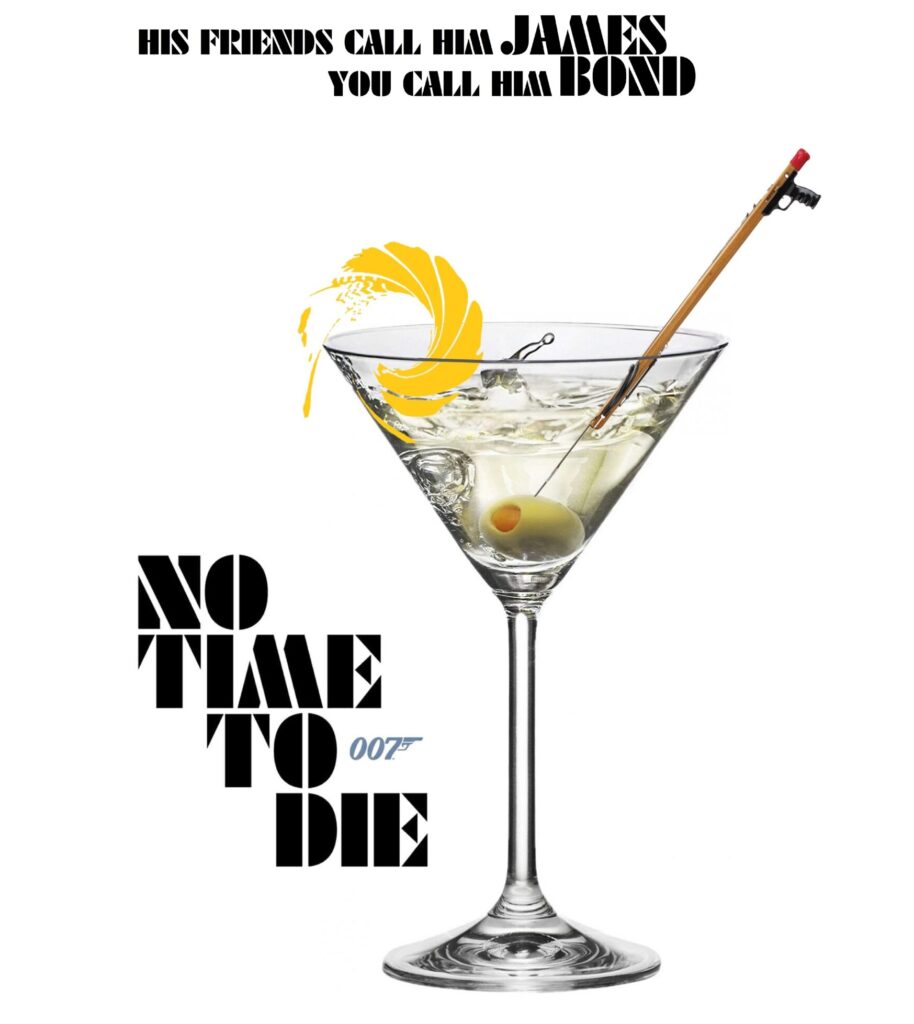
Art © Mark O’Connell
And with a silent descent through the London clouds and a clink of MI6 crystal, the film director born in San Francisco ends his Bond film with a quote written in San Francisco. In an almost direct lift from the You Only Live Twice novel – and an additional line author Ian Fleming lends Mary Goodnight to end M’s obituary of the assumed dead Bond – both Ralph Fiennes in the film and Goodnight in the book are actually quoting American novelist Jack London. ‘The proper function of man is to live, not to exist,’ London wrote in the San Francisco Bulletin in 1916, ‘ – I shall not waste my days in trying to prolong them. I shall use my time.’ It is a bleak ending for a Bond film. It has a finality like never before. It suggests we may not be continuing. Yet, if an Aston Martin V8 that had already died onscreen in 1987 can come back from the dead in No Time to Die, this bullet catcher is not fretting too much about the viability of a new 007 in Bond 26.
No Time to Die possibly represents Daniel Craig’s best performance as Bond. It is there when he impetuously interrogates Blofeld (Christoph Waltz) in Belmarsh Prison with a ‘Die, Blofeld! Die!’ (gleaned directly from Fleming’s You Only Live Twice). It is there when he stands by Vesper’s hilltop grave and breaks with a quiet beg for forgiveness. It is there when he stands up to Ralph Fiennes’ blisteringly perturbed M with a blunt ‘God, you’re thirsty today!’ And it is there when one of the boldest developments in the Bond movie franchise is revealed in that ever-dramatic Norwegian lake-house. As Bond finds Madeleine Swann in her family home, a small girl with piercing blue eyes sat at the top of a spiral staircase with her Slinky toy does indeed change everything. The ‘Daughter of SPECTRE’ has her own daughter, Mathilde (Lisa-Dorah Sonnet). And her father is Bond.
Bouncing off how the 1964 You Only Live Twice novel ends with Kissy Suzuki being pregnant, John Pearson’s fake memoir James Bond – The Authorised Biography (1973) cites a son called James Suzuki – a character which 007 continuation author Raymond Benson later features in his short story Blast from The Past (Playboy magazine, 1997). Yet, the notion of 007’s offspring in the Bond film canon is non-existent. Aside from that cocky Vegas kid in Diamonds Are Forever (1971), children have barely even featured in a Bond film. One could dismiss it as not in keeping with the cold, lone wolf nature of Bond. However, Daniel Craig has endowed the 007 franchise with a revived golden age of box-office fortune, critical success, and audience pride. Part of that narrative has explored the inner mechanisms of Craig’s Bond and the slowly revealed contexts of his life. The loss of his family, having no parents or next of kin, being an only child rattling around a Scottish homestead he despises, learning the hard way about how love kills and losing his ‘Mother’ figure in adulthood are all part of the DNA of Craig’s Bond. It would have jarred a standalone movie mission, but now makes total sense for this Bond to sign off with such a story beat. And even more so when we remember how impactful the birth of his own son Caspar was to Ian Fleming himself. The notion of killer parents, murdered families, surrogate work families and devastated childhoods is very much part of each and every one of Craig’s five Bond bullets.
Aside from a simply played breakfast moment with kids’ morning TV replacing Bond’s slow-drip coffee rituals, No Time to Die does not descend into Daddy Die Another Daycare sentiment. Craig instead shows us Bond quietly trying to get his own head around it all. And he does so with earned humour, a growing pride, and the simple warmth of lending his child his jumper – just as he once turned on a hot shower tap for Vesper Lynd with kind purpose.

In possible keeping with the Swann song nature of No Time to Die, the whole film is – more or less – set at sunset. Maybe mindful of the blood orange dusks of the tonal template that is On Her Majesty’s Secret Service, cinematographer Linus Sandgren (Don’t Look Up, First Man) painstakingly maintains a visual palette of constant dusk many a franchise would ditch, not notice, or lazily add later in post-production. Sandgren has cited cinematographer Allen Daviau’s work on Steven Spielberg’s E.T. the Extra Terrestrial (1982) as an influence for No Time to Die – and deliberately chose cameras and lenses that could bring that red lens flare look of E.T. to the film. Sandgren describes to the American Cinematographer Magazine (March 2020) how he approached assistant cameramen who had worked on E.T. The Extra Terrestrial to find out what specs and kit were used. From Spielberg’s 1982 ode to childhood to Bond 25‘s ode to parenthood, Sandgren’s results and influences are uncannily familiar – with the Norwegian forest scenes, the low-shot green ferns and a panicking Bond alone wilfully reminding of the overture to E.T. From M and Tanner panicking in the sundown light of MI6 corridors, those twilight-lit opening titles, a slither of evening sun bouncing off Nomi’s shades as she disembarks in Cuba, a twilight, low-shot Bond in the Aviemore forests doubling up as Norwegian wood, Bond and Nomi tearing onto an airbase in the Aston Martin DBS, a final missile attack on a villain’s lair and an eventide toast to a fallen colleague – no Bond film since perhaps On Her Majesty’s Secret Service has been so wholly mindful of what time of day it is set. And why. At a recent EON screening of the film, director Fukunaga thanked the crew for all those ‘sunset scrambles’ – those vital late-night set-ups, early morning call sheets and one-chance windows that ensured the sun conditions were exactly right. Every patiently harvested sunset shot is in the film. And the end-result is a golden and melancholic glow as the sun figuratively sets on the Daniel Craig era and the new golden age of Bond he bequeathed the series.
From double helixes to treble Felixes, Jamaican Ama girls to a Cuban Ana girl, Greek gods, strident tridents on Her Majesty’s Secret and Cinematic Service, and a wholly fitting Swann song… The Sunset Bullet that is No Time to Die is a bravura, bold and brave piece of Bond cinema. Daniel Craig used his time.
Mark O’Connell is the author of Catching Bullets – Memoirs of a Bond Fan
No Time to Die is now firing at the world’s movie screens.
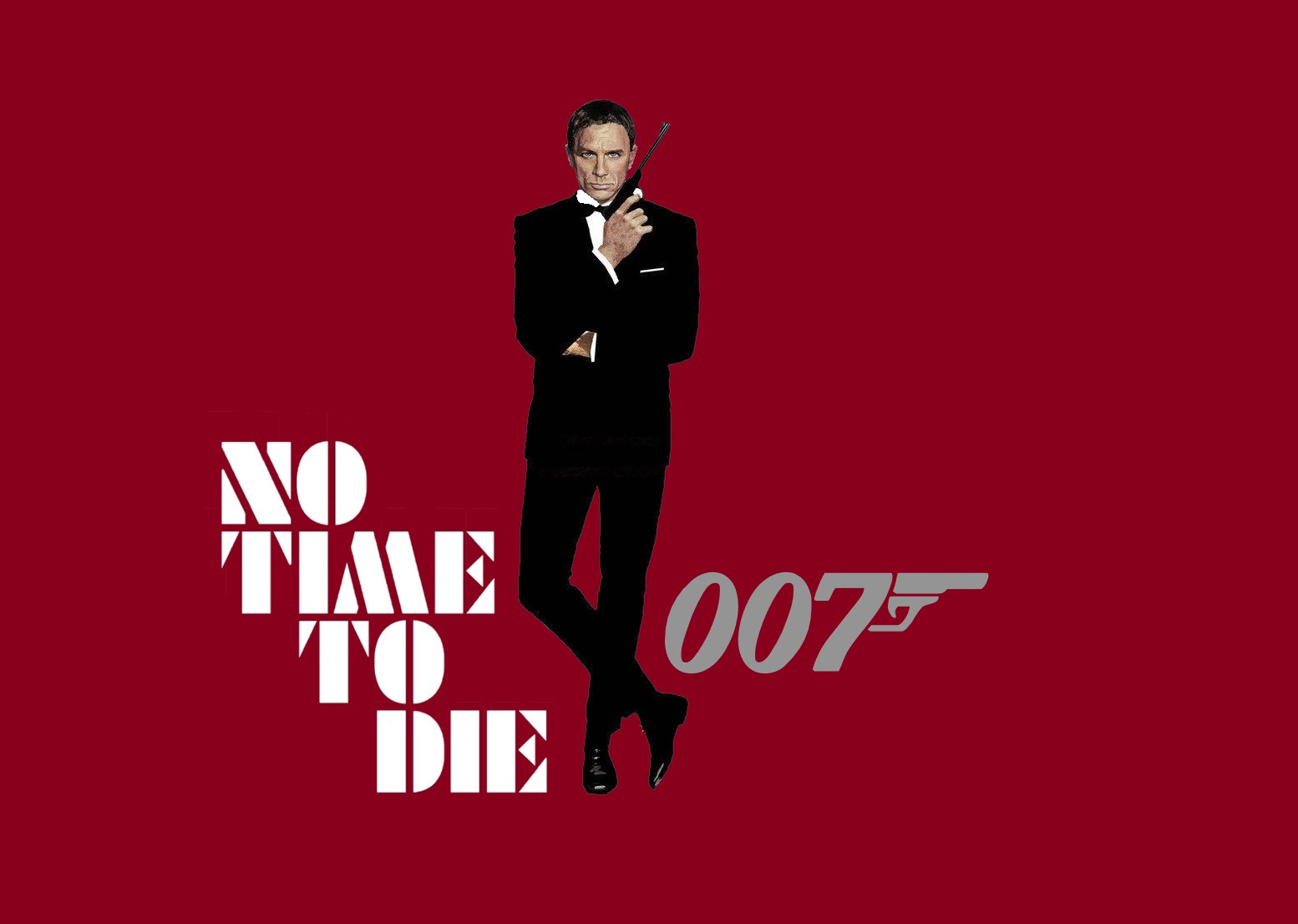
‘Daniel Craig’ by Robert McGinnis / Art © Mark O’Connell
